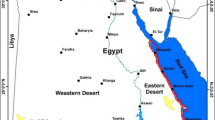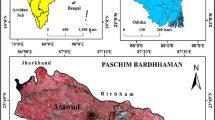Abstract
Human activities have great influence on fragile coastal ecosystem. For sustainable use of coastal resources it is very important to understand land use/land cover changes and its implications on coastal systems. Remote sensing data because of its synoptic, multispectral and multi temporal nature can be a very good source for mapping, monitoring and understanding these changes. IRS LISS III sensor data were used to find out the rate of land use/land cover changes in Hazira area near Surat, Gujarat. Because of major industrial activities it has become a hot spot area which requires regular monitoring. In the present study, land cover information of the period 1970–1972 from the Survey of India topographical maps, and satellite data of the year 1989 and 1999–2002 have been used and visual analysis has been carried out to measure the land use/land cover changes. Erosion and deposition has been observed around the newly constructed jetty. Forest area and agriculture area is found to decreased, whereas built-up area has increased.
Similar content being viewed by others
References
Anderson, J.R., Hardy, E.E., Roach, J.T. and Witmer, R.E. (1976). A land use and land cover classification system for use with remote sensor data.U.S.GS. Prof. Paper,964: 1–26.
Andreae, M.O. (2002). Humanity: passenger or pilot on the spaceship earth?Global Change (IGBP) News Letter,52: 2–7.
Campbell, James B. (1996). Introduction to Remote Sensing. Taylor & Francis. London.
Green, K., Kempka, D. and Lackley, L. (1994). Using remote sensing to detect and monitor land cover and land use changes.Photogramm. Engg. and Remote Sensing,60(3): 331–337.
Justice, C.O., Townshend, J.R.G., Holben, B.N. and Tucker, C.J. (1985). Analysis of phenology of global vegetation using meteorological satellite data.Int. J. Remote Sensing,6(8): 1271 -1318.
Kam, T.S. (1995). Integrating GIS and remote sensing techniques for urban land-cover land-use analysis.Geocarto International,10(1): 39–49.
King, R.B. (2002). Land cover mapping principles: a return to interpretation fundamentals.Int. J. Remote Sensing,23(18): 3523–3545.
Lindbhoom, H., Crossland, C. and Kremer, H. (2002). Land ocean interactions — towards LOICZ II.Global Change (IGBP) News Letter,50: 24–30.
Land use and land cover change implement strategy (1999). IGBP report 48 (Eds.: Nunes C. and Ange, J.I.).
Lillesand, T. M. and Kiefer, R.W. (1994). Remote sensing and image interpretation. John Wily, New York.
Luque, S.S. (2000). Evaluating temporal changes using Multi-Spectral Scanner and Thematic Mapper data on the landscape of natural reserve; the New Jersey Pine Barrens, a case study.Int. J. Remote Sensing,21(13): 2589–2611.
Maselk, J.G., Lindsay, F.E. and Goward, S.N. (2000). Dynamics of urban growth in the Washington DC Metropolitan area, 1973–1996, from Landsat observations.Int. J. Remote Sensing,21(17): 3473–3486.
Mcconnell, W. (2001). How and why people and institutions matter beyond economy: People and trees in Madagascar.Global Change (IGBP) News Letter,47: 20–22.
Nayak, S.R. and Sahai, B. (1983). Morphological changes in the Mahi Estuary. Proc. National conference on “Application of Remote Sensing to national Resources, Environment, Land use and problems relating to Training and Education.” Centre of Studies in Resources Engineering, IIT, Bombay, pp. 152–154.
Nayak, S.R., Gupta, M.C. and Chauhan, H.B. (1985). Monitoring of wetland and shoreline on the part of Gujarat coast using Landsat data. Proc. 6th Asian Conf. Remote Sensing, Hyderabad, pp. 348–353.
Nayak, S.R.,et al. (1986). Application of Landsat data for coastal zone monitoring: a case study of a part of west coast of India. Proc. “Regional seminar on the Application of Remote sensing Techniques to Coastal Zone management and the Environmental Monitoring”. Bangladesh Space Research Organisation and UNDP/ESCAP, Regional Remote Sensing Programme. Dhaka, Bangladesh, pp.320–327.
Nayak, S.R.,et al. (1989). Application of satellite data for monitoring degradation of tidal wetlands of the Gulf of Kachchh, Western India.Acta Astronautica,20: 171–178.
Nayak, S.R.,et al. (1991). Manual for mapping of coastal wetland/landforms and shoreline changes using satellite data. Technical note, Space Applications Center, Ahmedabad. IRS-UP/SAC/MCE/TN/32/91, 63p.
Rasch, H. (1994). Mapping of vegetation, landcover, and land use by satellite — experience and conclusions for future project applications.Photogramm. Engg. and Remote Sensing,60(3): 265–271.
Singh, A. (1989). Review article — digital change detection techniques using remotely sensed data.Int. J. Remote Sensing,10(6): 989–1003.
Slater, J. and Brown, R. (2000). Changing landscapes: monitoring Environmentally Sensitive Areas using satellite imagery.Int. J. Remote Sensing,21(13): 2753–2767.
Tucker, C.J. (1979). Red and photographic infrared combinations for monitoring vegetation.Remote Sensing Env.,8(2): 127–150.
Vink, A.P.A. (1975). Land use in advancing in agriculture. Springer-verlog, Berlin.
Wilson, J. and Hick, P. (2002). The use of Landsat derived multi-temporal NDVI to assess the impact of the construction of the Central Pilbara railway on vegetation conditions, Karijini National park, Western Australia.Geocarto International,17(1): 13–20.
Yang, X. and Lo, C.P. (2002). Using a time series of satellite imagery to detect land use and land cover changes in Atlanta, Georgia metropolitan area.Int. J. Remote Sensing,23(9): 1775–1798.
Author information
Authors and Affiliations
Corresponding author
About this article
Cite this article
Chauhan, H.B., Nayak, S. Land use/land cover changes near HAzira Region, Gujarat using remote sensing satellite data. J Indian Soc Remote Sens 33, 413–420 (2005). https://doi.org/10.1007/BF02990012
Received:
Revised:
Issue Date:
DOI: https://doi.org/10.1007/BF02990012




